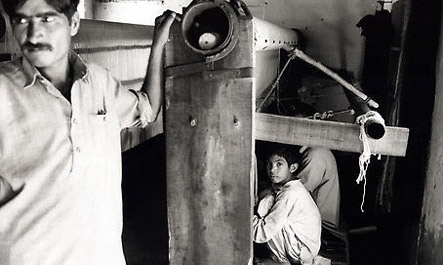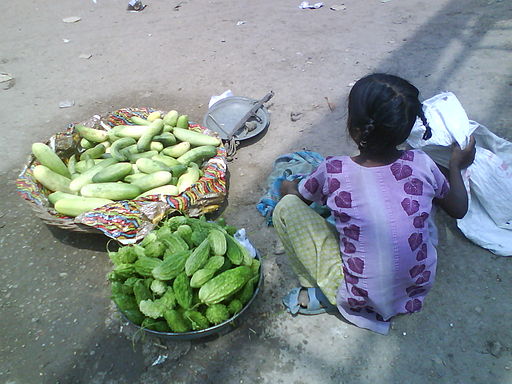Ravi, a boy who lives in the semi-arid northern plateau of Karnataka, spends his days herding his own flock of twelve sheep as they search for green grass to graze on. Ravi studied in his village school up to the 5th standard but has dropped out since; “I was not good at studies, and the teachers used to hit me… I gained nothing from going to school, I gain much more from these sheep,” he says.
Ravi was only seven years old when he started looking after sheep and has accumulated his own flock by now. Ravi has dropped out of school and has started working, earning a living off of his sheep and he faces daily challenges as well as success in these pursuits. Yet, he is only a child still.
Many organisations, local and international, advocate the criminalisation of child labour. They assert that work is detrimental to children and their rightful place is in school. Most of them provide heartbreaking examples of children working in deplorable conditions, enduring abuse, and failing to get an education. However, Bengaluru-based NGO, The Concerned for Working Children (CWC), has a slightly different take on this.

Kavita Ratna, the Director of Advocacy at The Concerned for Working Children, explains that a blanket ban on child labour is problematic because “it does not address the root causes, it does not provide viable alternatives to children, and it actually ends up criminalising and traumatising the child much more than in the working phase of the child’s situation.”
The criminalisation of working children and their employers does not solve the problem that leads to child labour, such as abstract poverty, degraded agricultural land, and expanding urbanisation. Given the above realities, laws of absolute abolition merely push working children into illegal forms of employment, putting them at further risk of abuse. “They are becoming invisible, they do it where we can’t see them. And where we can’t see them they are even more exploited,” says Kavita.
No work or good work?
Many laws have been enacted in the country over the years that aim to protect children. The Child Labour (Prohibition & Regulation) Act, 1986 and the Factories Act (1948) outlawed the employment of children in factories and a variety of positions in many sectors. The Juvenile Justice (Care and Protection) of Children Act of 2000 made it illegal and punishable to employ children in hazardous jobs or keep them in bondage.The Right of Children to Free and Compulsory Education Act of 2009 mandates that free education be given to all children aged 6-14.

Bans notwithstanding, the use of child labour is rampant. Photo Courtesy: Shirish Khare.
The CWC draws attention to the fact that the ban on child labour in India has not made any progress in reducing the number of working children. It argues that there is a difference between child labour and child work. ‘Child labour’ is detrimental to a child’s health and development while ‘child work’ is not only safe, but contributes to a child's education, skills and confidence.
Kavita explains, “we talk of a ‘no work’ situation, but we don’t talk about a ‘positive work’ situation. We do not look at how to make that particular work positive, or safe. We will not ever do that unless we also recognise that there are positive elements in a work environment.”
She argues that there are many jobs that provide children an education in an informal way. CWC has helped hundreds of working children and discovered that many of them have in the course of their work developed skills in addition and subtraction; they understand interest rates on loans, installments, depreciating value, the change in rates at the end of a business day, and speak many languages.
The organisation argues that many of the government’s methods of “rehabilitating” working children do not take into account the value of the jobs these children have held. “The whole debate over working children has become so black and white that anything to do with work or labour is considered a completely black experience, which is not so,” says Kavita.
Recent changes
On the face of it, it would seem that the government, too, has taken note of the fact that the child labour dialogue has two sides to it: the Cabinet, on 13 May, approved certain amendments to the 1986 Act, allowing children under 14 years to work with families, or in non-hazardous family-run enterprises, including agriculture and home-based work, forest gathering after school hours or during vacations. Another exception was made for children to work in the audio-visual and entertainment industry.
However, the CWC came down heavily on this, terming the amendments ‘sketchy’ and the exceptions arbitrary. “Even as the Government recognises that the roots of hazardous child work are imbedded in poverty in its text, it does little else in response. The 2012 Amendment speaks nothing of preventive measures, provisioning other choices for the child – both in the short and the long term or re-imagining education in a manner made accessible and appropriate to them,” said the official communiqué from the organisation.
The path to a world with no child labour
CWC may be against the criminalisation of child labour, but they do hope for a child labour free world, achieved through a carefully deliberated set of strategies.
Kavita says that the very first step to ending child labour would be to decentralise the problem. “When you decentralise the problem, you are looking at small groups of children and you are able to understand what their particular story is. The response to each child has to be varied, depending on why that child is being forced to work or why that child is even choosing to work.” A blanket solution imposed by the government does not address the core issues and can add to the problems these children face.
The government's current solution is to “raid” businesses that employ children and send them to government institutions. But these places are not what most would hope them to be. After visiting these homes, one is often not sure whether the children are indeed much better off than they were when they were working. “There is a lot of abuse happening there, they’re not even fed properly, there is zero learning,” says Kavita, highlighting the ills of the usual rehabilitation centres.
Even after the recent approval of the amendments, the CWC maintains, “Without addressing reasons for why children work in difficult circumstances, the ban just implies a continuation of the current simplistic and often deeply traumatising experience of ‘raid and rescue’ combined with institutionalisation for children who are working. The current Act and Amendment also continues to penalise parents for ‘allowing’ children to work without responding to their circumstances in any real manner.”
The organisation draws attention to the reality that many working children are doing so out of choice. They may be young, but they understand the financial burden their parents carry so they take on work to ease the load. Other children do not succeed in the educational environment provided so they take to their local streets and shops to find work and develop skills.

A child street vendor. Pic: Wikimedia Commons
Kavita explains, “For a lot of children, the school system doesn’t give them anything the way it is now. So for them they don’t find school beneficial also.They probably see the work more beneficial, yes there is a hardship but they see some benefits to that hardship. They are making a choice in those cases.”
There are many children like Ravi who can’t see a bright future resulting from school. In Ravi’s interview, his friend explains how the other kids in his village have barely learned to read, they have not moved on in their lives despite having continued studies in school, and they are just waiting to get married. The current education system not only lacks the ability to educate but also fails to motivate students.
In an official statement to mark the World Against Child Labour Day (12 June), the CWC raises yet again the criticality of choice and the freedom of children to express that choice. It recalls an instance at a meeting of the International Working Group on Child Labour at Bangalore in 1994, when Ramu, a fifteen year old member representing the Bhima Sangha (Union of Working Children) strongly asserted: “Children need support to bring an end to child labour and to express themselves. Our previous experience has been that when children began to speak, grown-ups get up and leave. I would like to ask those here at this meeting to have patience when children speak and listen to them until they finish. You should tell as many people and children, including those who go to school, about our situation.”
Thirteen years since the International Labour Organization (ILO) launched the World Day Against Child Labour in 2002, voices of children are still missing from the international dialogue on child labour. “This not only implies that international bodies like the ILO are themselves in a dilemma over how to truly actualize the right to be heard that is embedded within the UN Convention on the Rights of the Child (UNCRC) but also, more importantly, that the many finer points of the contextualized realities of the children, do not get fair representation in the conversation,” says the CWC.
Yet another strategy advocated by the CWC involves strengthening of local governments. According to Kavita, “The smaller they are, the more effective they are in terms of reaching the child. However, a local government has to have a critical size to be able to function as a viable government unit.”
The local government also needs to be easily accessible and able to reach out to the people it governs. Wherever this is possible, the community aided by the government can provide the most appropriate solutions. “In many areas where we work, we have applied these strategies and we have been able to create child labour free areas without a single child being forcibly pulled out of work. Because if you address the issues surrounding the issue of child labour and if you actually provide an alternative based on that, it is a worthy solution,” says Kavita.























